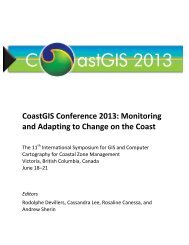in Context the SCotian Shelf - COINAtlantic
in Context the SCotian Shelf - COINAtlantic
in Context the SCotian Shelf - COINAtlantic
Create successful ePaper yourself
Turn your PDF publications into a flip-book with our unique Google optimized e-Paper software.
Zwanenburg et al. 2006). Globally, historic fish<strong>in</strong>g<br />
trends have shown fish<strong>in</strong>g progress<strong>in</strong>g from <strong>the</strong><br />
most valuable and easiest to catch species, which<br />
tend to be large, fish-eat<strong>in</strong>g fish, to lower trophic<br />
levels, such as <strong>in</strong>vertebrates and plankton-eat<strong>in</strong>g<br />
fish 3 (Pauly et al. 1998). The focus of <strong>the</strong> fishery has<br />
also moved from shallow coastal waters, to deeper<br />
offshore waters. Large scale removal of a particular<br />
species or multiple species may <strong>in</strong>fluence energy<br />
flow <strong>in</strong> <strong>the</strong> ecosystem as well as o<strong>the</strong>r ecosystem<br />
properties (see e.g., Zwanenburg et al. 2006). There<br />
is evidence that <strong>the</strong> trophic structure of <strong>the</strong> eastern<br />
Scotian <strong>Shelf</strong> has changed as a result of <strong>the</strong> decl<strong>in</strong>e<br />
of <strong>the</strong> cod population (Frank et al. 2005).<br />
Fish<strong>in</strong>g removes non-target species from <strong>the</strong><br />
system, affect<strong>in</strong>g <strong>the</strong>ir populations. If <strong>the</strong> bycatch is<br />
high enough, if may have similar effects on particular<br />
species as directed fish<strong>in</strong>g.<br />
4.2 Incidental <strong>in</strong>jury/mortality<br />
Many activities on <strong>the</strong> Scotian <strong>Shelf</strong> may result <strong>in</strong><br />
accidental <strong>in</strong>jury or death to <strong>the</strong> species. Shipp<strong>in</strong>g,<br />
fish<strong>in</strong>g, aquaculture, and construction of offshore<br />
and coastal <strong>in</strong>frastructure may all result <strong>in</strong> <strong>in</strong>cidental<br />
<strong>in</strong>jury or mortality. Incidental catches of non-target<br />
species by fish<strong>in</strong>g (bycatch) are noted above. Incidental<br />
impacts may result <strong>in</strong> a significant overall effect<br />
at <strong>the</strong> population level. For example, two of <strong>the</strong><br />
key threats to <strong>the</strong> endangered North Atlantic right<br />
whale are <strong>in</strong>cidental impacts: collisions with ships<br />
and entanglement <strong>in</strong> fish<strong>in</strong>g gear.<br />
4.3 Benthic Habitat DistuRBance<br />
Human activities on <strong>the</strong> Scotian <strong>Shelf</strong> may disturb or<br />
damage mar<strong>in</strong>e habitat, particularly benthic habitat.<br />
Fish<strong>in</strong>g, construction of offshore and coastal <strong>in</strong>frastructure,<br />
discharges from oil and gas operations and<br />
disposal at sea may all impact mar<strong>in</strong>e benthic habitats.<br />
The impacts of different types of fish<strong>in</strong>g gear on<br />
benthic habitat have been documented <strong>in</strong> a number<br />
of reports and <strong>in</strong>clude changes <strong>in</strong> habitat complexity,<br />
changes <strong>in</strong> seafloor structure (e.g., through movement<br />
of rocks and boulders or creation of furrows),<br />
as well as removal of structure-build<strong>in</strong>g organisms,<br />
such as corals and sponges (DFO 2006). Fish<strong>in</strong>g<br />
may also impact <strong>the</strong> composition of benthic communities<br />
(DFO 2006).<br />
4.4 Noise<br />
Mar<strong>in</strong>e construction, seismic surveys carried out by<br />
<strong>the</strong> petroleum <strong>in</strong>dustry, various types of SONARs,<br />
and vessels used <strong>in</strong> various activities are <strong>the</strong> ma<strong>in</strong><br />
contributors of noise <strong>in</strong> <strong>the</strong> mar<strong>in</strong>e environment of<br />
<strong>the</strong> offshore Scotian <strong>Shelf</strong>. Low-fly<strong>in</strong>g aircraft may<br />
also be major contributors <strong>in</strong> certa<strong>in</strong> areas, such as<br />
near Sable Island (LGL Limited and Malme 2000).<br />
Mar<strong>in</strong>e mammals use sound to vary<strong>in</strong>g degrees for<br />
several purposes: communication; forag<strong>in</strong>g; orientation<br />
<strong>in</strong> <strong>the</strong> water; and predator avoidance (Götz et al.<br />
2009). Some fish species are known to use sound<br />
for communication and may also use it for orientation,<br />
although sound use <strong>in</strong> fish species has not been<br />
<strong>in</strong>vestigated very thoroughly (Götz et al. 2009). O<strong>the</strong>r<br />
mar<strong>in</strong>e animals, <strong>in</strong>clud<strong>in</strong>g <strong>in</strong>vertebrates, turtles and<br />
birds, may also be sensitive to sounds, depend<strong>in</strong>g<br />
on <strong>the</strong> type and frequency. Mar<strong>in</strong>e mammals<br />
produce sounds <strong>in</strong> a wide variety of frequencies and<br />
<strong>the</strong>ir hear<strong>in</strong>g spans a similarly wide range (Götz et<br />
al. 2009). Thus, different sounds will have different<br />
impacts on mar<strong>in</strong>e species. More <strong>in</strong>formation can be<br />
found <strong>in</strong> a report of <strong>the</strong> OSPAR Commission (Götz et<br />
al. 2009), which carried out a review of <strong>the</strong> impacts<br />
of human produced sound <strong>in</strong> <strong>the</strong> mar<strong>in</strong>e environment.<br />
Mar<strong>in</strong>e mammals have traditionally been<br />
considered <strong>the</strong> most vulnerable to noise and an<br />
assessment of noise issues relevant to two species of<br />
52 http://co<strong>in</strong>atlantic.ca/<strong>in</strong>dex.php/state-of-<strong>the</strong>-scotian-shelf<br />
3<br />
This is a simplification of general trends: <strong>the</strong>re have long been some <strong>in</strong>vertebrates (e.g., lobster, scallops) and planktivorous fish (e.g., herr<strong>in</strong>g) that have been fished.













